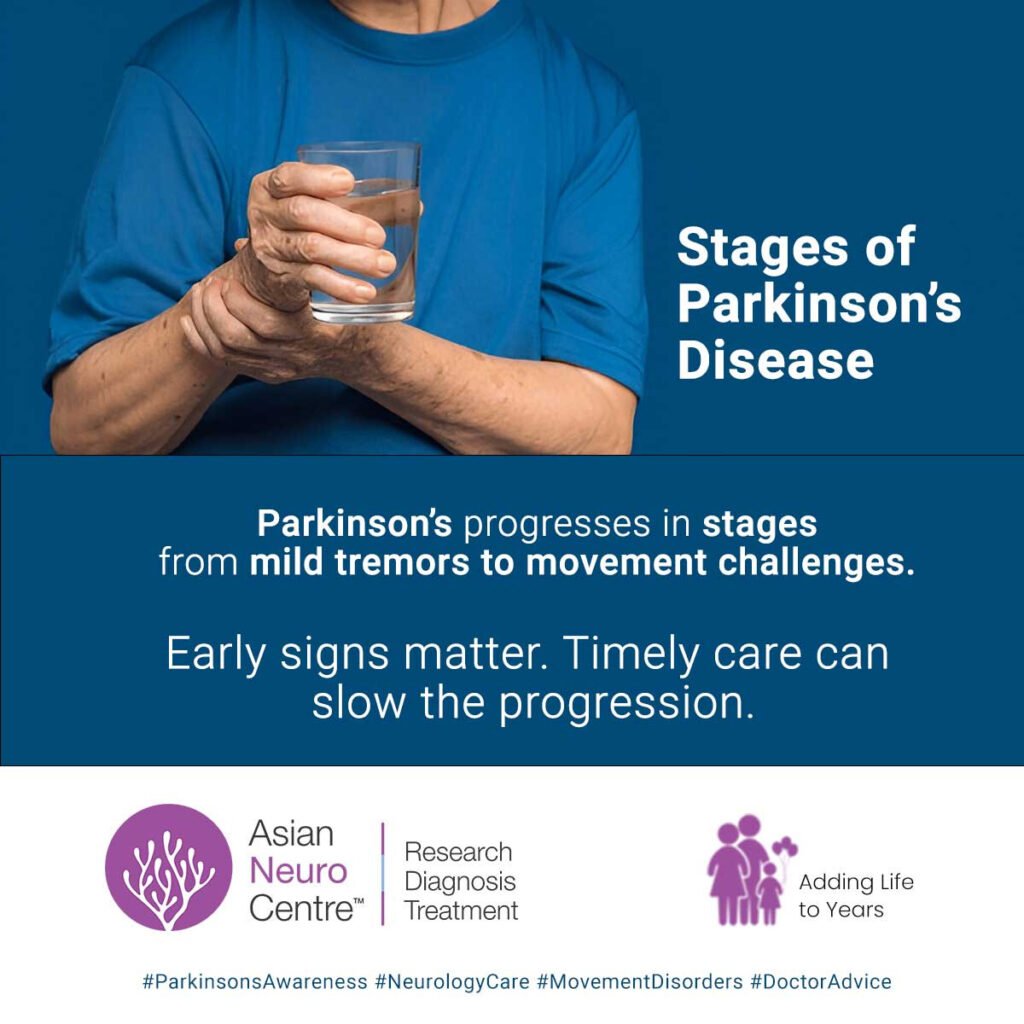- Have any questions?
- 911 12345 29
- info@asianneurocentre.com
What are the Stages of Parkinson’s Disease?
What are the Long Term Consequences of Epilepsy on the Brain?
July 14, 2025पार्किंसन रोग किस उम्र में होता है?
July 25, 2025What is Parkinson’s Disease (PD)
Parkinson’s disease (PD) is a progressive neurodegenerative disorder that primarily affects movement. It is caused by the degeneration of cells that produce dopamine in a certain area in the brain known as the substantia nigra. As these cells die, the dopamine level drops, thereby causing the characteristic motor symptoms of PD.
The developmental stages of the disease are usually categorized into stages in order to allow healthcare professionals to measure the severity of the disease and plan the treatment accordingly. The most used system is referred to as the Hoehn and Yahr classification, which identifies 5 stages.

What are the Stages of Parkinson’s Disease?
The Hoehn and Yahr scale categorizes the functional disability caused by Parkinson’s disease, providing a framework for understanding its progression. It’s important to remember that the rate of progression varies significantly from person to person.
Stage 1: Mild, Unilateral Symptom
During this early phase, the symptoms are only mild and typically do not affect the daily lives of the patients. Movement-related symptoms, such as tremors, rigidity, or slowness of movement (bradykinesia), are typically present on only one side of the body.
Postural changes, gait alteration, or changes in facial expression can be slight and not noticed easily. Symptoms at this level are usually at a moderate level to such an extent that at that level there is no need to carry out medication, or in case there should be the need, there can be medication that can effectively control the symptoms.
Stage 2: Bilateral Symptoms, No Balance Impairment
When the disease enters Stage 2, symptoms are more evident, and on both sides of the body. Tremor, rigidity, and bradykinesia are now present on both sides, but they might still appear worse on either side. Issues with keen walking and poor posture are enhanced.
Such transformations do not force people to lose their balance and be unable to live independently, but the daily activities can become more rigid and require more time to be performed.
Stage 3: Mid-Stage, Loss of Balance
Stage 3 is considered the middle stage of Parkinson’s and marks a significant turning point. The most significant feature of the given stage is the compromise of balance and vulnerability to falls.
Though people are physically independent and able to carry out most of their everyday duties, they are slower in movement, and problems with balance might demand greater attention not to fall. Medications might not be as effective as before.
Stage 4: Severe Disability, Assistance Required
Stage 4 has completely developed symptoms, and these individuals have severe disabilities. Although people can still stand and walk without an aid, the capacity to do so is greatly affected, and a person needs assistance, which can come in the form of a walker, most of the time.
Most individuals in this stage cannot live without much care as their movement and reaction time have drastically reduced, and most people at this stage need a lot of assistance in their daily functions such as bathing, dressing, and eating habits.
Stage 5: Advanced Stage, Bedridden or Wheelchair-Bound
This is the most advanced and debilitating stage of Parkinson’s disease. This can cause extreme stiffness in the legs to the larger extent that one is not able to stand or walk, thus the person is bound to either bed or a wheelchair.
Around-the-clock assistance is required for all activities of daily living and to prevent falls. Non-motor symptoms, such as cognitive impairment, confusion, hallucinations, and delusions, are also more common and pronounced in this final stage.
Important considerations
- Non-motor symptoms: While the Hoehn & Yahr scale focuses on motor symptoms, it’s important to remember that Parkinson’s also involves non-motor symptoms like sleep disturbances, mood changes, and cognitive problems.
- Individual variability: The progression of Parkinson’s disease varies from person to person. Not all people will develop according to the schedule.
- Living with Parkinson’s: Even in advanced stages, people with Parkinson’s can still live well with the right support and treatment.
Conclusion
The staging of Parkinson’s disease provides a valuable framework for understanding its progressive nature and the impact it has on an individual’s motor and non-motor functions. While the Hoehn and Yahr scale focuses primarily on motor symptoms, it highlights the increasing levels of disability as the disease advances.
Each stage presents unique challenges, underscoring the importance of ongoing medical management, supportive therapies (like physiotherapy and occupational therapy), and comprehensive care to help individuals with Parkinson’s maintain the best possible quality of life at every stage.
Dr. Navin Tiwari
Consulting Neurologist
